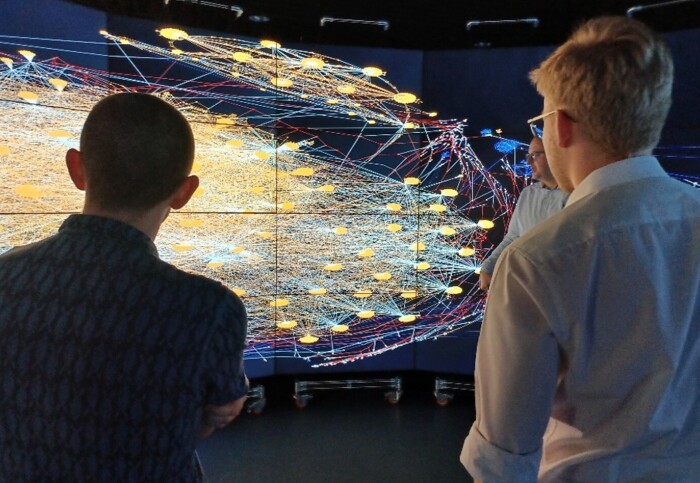Data Analysts from the Cabinet Office visit the Data Observatory
by Gemma Ralton

15 members of the Cabinet Office’s National Situation Centre visit the Data Observatory to learn about large scale visualisation techniques.
In June 2024, Data Analysts, Data Scientists from the National Situational Centre came to visit the Data Science Institute’s Data Observatory facility – a circular wall comprised of 64 monitors, 313 degrees of surround vision and 130 million pixels.
Designed, built by, and housed within the Data Science Institute, the Data Observatory enables decision-makers to derive new implications and actions from interrogating data sets in an innovative and immersive environment.
The National Situation Centre (SitCen) was established to bring data, analysis, and insight together, boosting the government’s ability to identify, monitor, and manage risks. For example, during the July 2022 extreme heatwave, the SitCen worked with partners to identify vulnerable groups and locations, enabling responders to target support effectively.
During the visit Research Fellow and Data Observatory Lead Dr Ovidiu Serban, and Systems Engineer in Large Scale Data Visualisation Mr Brython Caley-Davies, showcased various demonstrations in the Observatory including interactive maps, visualising dynamic bitcoin transaction patterns, and predicting road traffic collision impact using social media data.
“This was a fascinating visit. We're undertaking a programme to make greater use of modern data visualisation technologies to better inform government decision makers during national crises, and it's great to learn from Dr Serban and Imperial.” Two Crisis Response Leads National Situation Centre
The Cabinet Office visitors were interested in learning more about how the Observatory environment can be used to showcase data in an innovative way. They also engaged in technical discussions around data analysis and visualisation for critical decision-making and how content can be adapted for different users, with dynamic datasets such as financial transactions or social media data, or how to represent dynamic elements without overwhelming the users with animations.
Dr Serban commented on the visit: “This was an excellent opportunity to showcase our research and the capabilities of the Data Observatory as a research facility. We hope for collaborations in the future on human-centred data science and visualisation, with a strong emphasis on adaptable systems that support quick and transparent decision-making.”
Two Crisis Response Leads from the National Situation Centre, commented on the visit: “This was a fascinating visit. We're undertaking a programme to make greater use of modern data visualisation technologies to better inform government decision makers during national crises, and it's great to learn from Dr Serban and Imperial.”
Article text (excluding photos or graphics) © Imperial College London.
Photos and graphics subject to third party copyright used with permission or © Imperial College London.
Reporter
Gemma Ralton
Faculty of Engineering